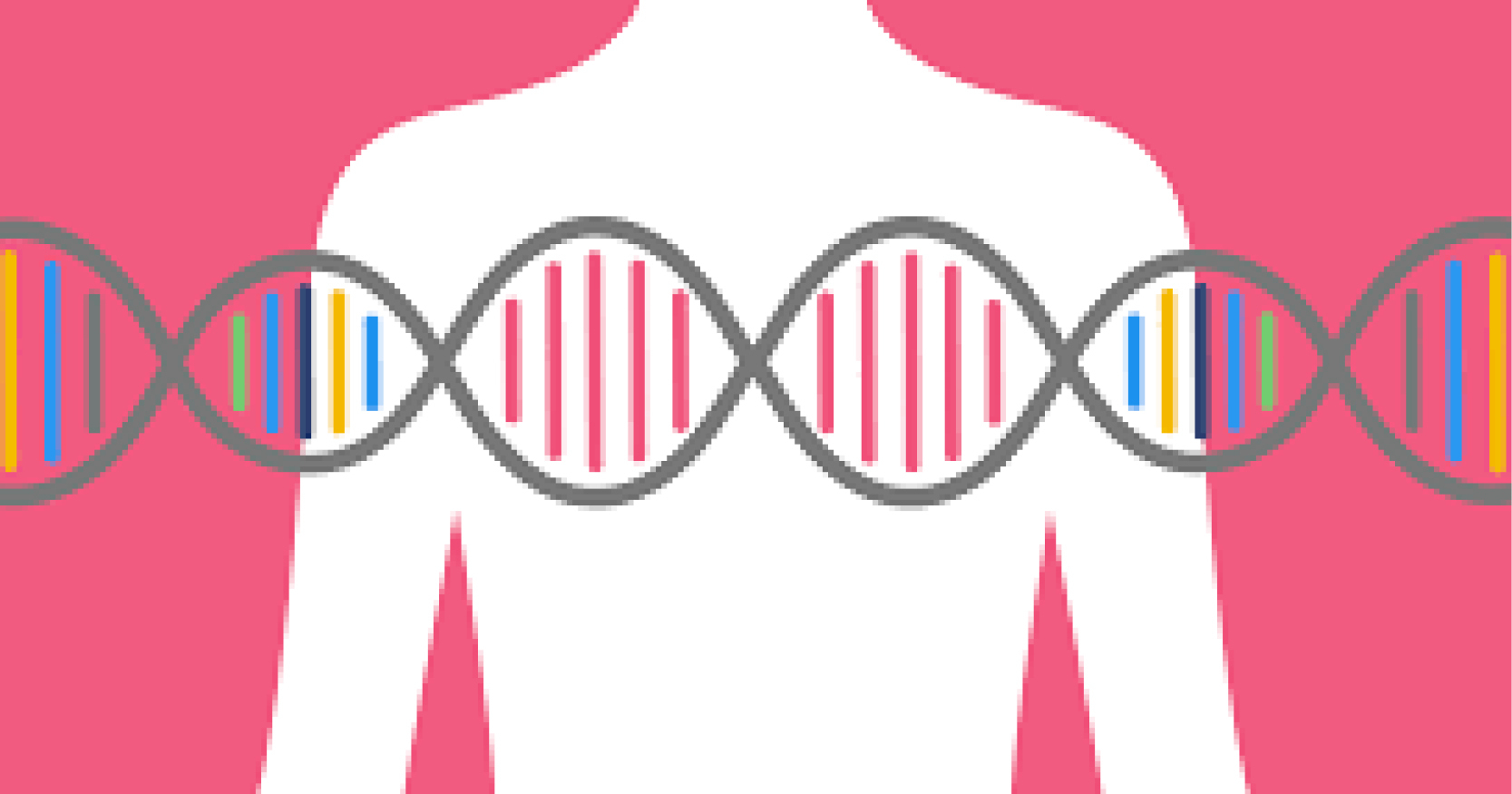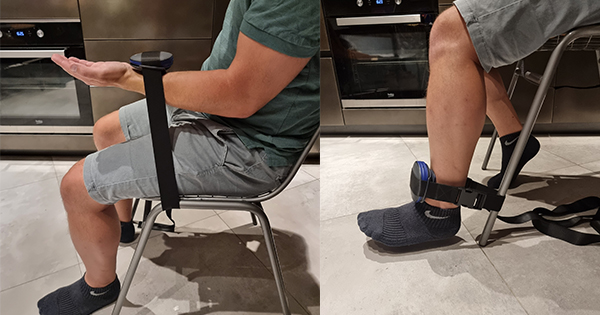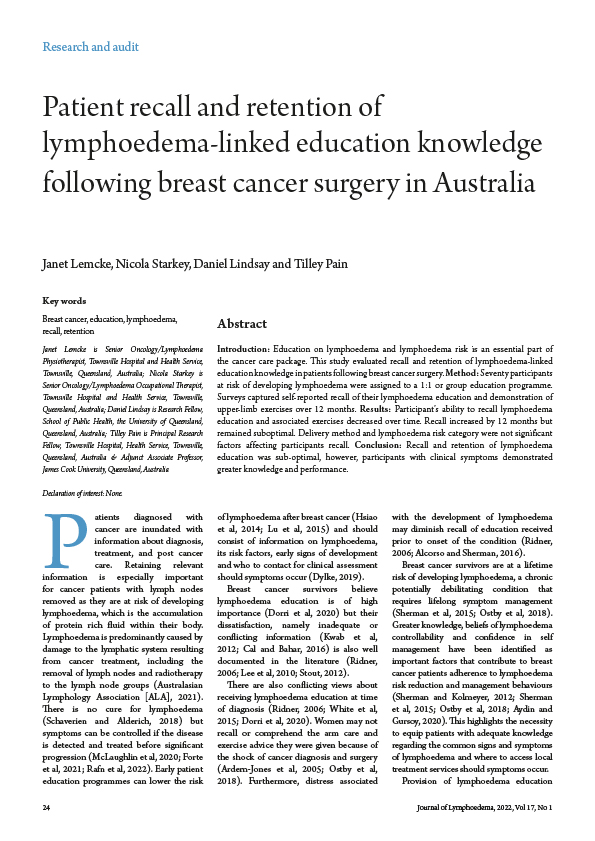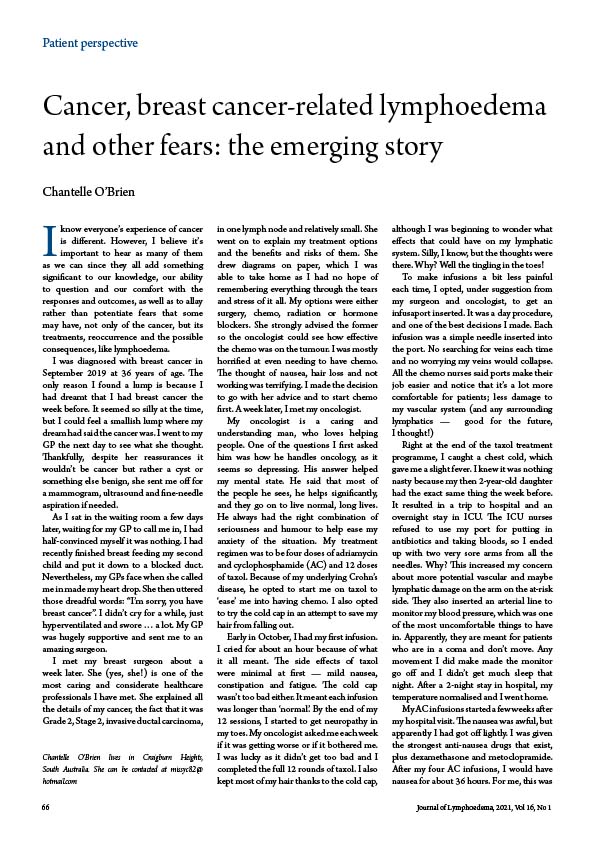Secondary lymphoedema may occur as a sequela of lymph node dissection and have an adverse impact on quality of life (Tiwari et al, 2013; Rafn, 2022). The main risk factors for lymphoedema are radiotherapy, obesity, infection, and taxane-based chemotherapy (McLaughlin et al, 2020; Cariati et al, 2015; Shah et al, 2016). In Japan at least, secondary lymphoedema is estimated to occur in about 16% of patients with cancer, which translates into approximately 150,000–160,000 people (Shigematsu, 2019).
Furthermore, 85% of cancer deaths occur in patients aged 65 years or older (Cancer Statistics, 2022). Therefore, the number of older patients with secondary lymphoedema can be expected to increase further with population ageing.
The International Society of Lymphology (ISL) international consensus document stresses the importance of early detection of lymphoedema (Executive Committee of the International Society of Lymphology, 2020). Furthermore, it is necessary to know exactly when lymphoedema is most likely to occur following lymph node dissection. It has been reported that the risk of upper limb lymphoedema (ULL) is highest at 12–30 months after lymph node dissection (Shah et al, 2016). Other reports suggest that lymphoedema is most likely to occur at approximately 12 months after surgery (Armer, 2011; McDuff, 2019).
Patient implementation of self-management (SM) skills is essential to limit the severity of lymphoedema (Douglass et al, 2016; Temur, 2019). We have previously surveyed SM skills for preventing severe lymphoedema at around 12 months postoperatively in participants with gynaecological cancer and those with breast cancer, in that survey we found that even though participants had received education in the postoperative period, their knowledge did not correlate with implementation of SM skills (Izawa et al, 2021).
We also found differences between patients with breast cancer and those with gynaecological cancer in the way lymphoedema was observed depending on site and in lifestyle behaviours related to exacerbation of symptoms. Therefore, SM skills must be considered according to the type of cancer in view of the differences in how they are implemented (Vural et al, 2020). Unlike gynaecological cancers, patients with breast cancer can be expected to notice early the appearance of symptoms in the sense that they develop on the affected limb site after surgery.
Education on how to prevent severe lymphoedema is generally provided in the postoperative period for patients who have undergone surgery for breast cancer. However, barriers to implementing SM skills to prevent severe lymphoedema have been identified (Armer, 2011) and it has also been reported that cancer survivors are physically and emotionally damaged by their treatment (Cemal et al, 2013). The purpose of this study was to investigate the SM skills of patients with breast cancer who are educated on how to prevent lymphoedema and the associations of these skills with patient characteristics and occurrence of lymphoedema.
Methods
Selection and description of participants
The study was performed at Kyoto University Hospital, which is located on the west side of Japan, and used a quantitative descriptive approach. Data were collected from participants recruited sequentially between April 2019 and April 2020. Medical records were screened for potentially eligible study participants those invited to participate during their next visit to the outpatient clinic.
The following inclusion criteria were applied: lymph node dissection for breast cancer 12–18 months before enrolment in the study; age over 20 years; education on lymphoedema SM skills provided by a nurse once after surgery or twice in the first month after discharge. Participants who had limb oedema with another cause, those who were considered physically or mentally unsuitable for participation in the opinion of their attending physicians, and those who had undergone bilateral lymph node dissection were excluded. Education on prevention of severe lymphoedema is standardised in Japan and includes providing knowledge on symptoms of lymphoedema, worsening early symptoms, and use of everyday precautionary measures, including prevention of infection, skin care, and self-lymphatic massage. Nurses provide each participant with about 20 minutes of guidance based on a pamphlet widely used in Japanese hospitals that have cancer treatment facilities.
Epidemiological and clinical characteristics of study participants
Information on age, disease stage, time elapsed since lymph node dissection, number of lymph node metastases, and postoperative treatment was extracted from the medical records. Body mass index was calculated using the participant’s height and weight (kg/m2). We also collected demographic information, including on marital and employment status and academic background. Information on previous lymphoedema education was extracted from the medical records.
Measurement of oedema volume and grade
Measurements of participants’ upper limbs were obtained to detect lymphoedema after obtaining informed consent from the study participants at the outpatient clinic. The upper limb was measured starting from the wrist and at 4-cm intervals up to the axilla. Finally, the volume of both upper limbs was calculated using Limb Volume Program software (Academy of Lymphatic Studies, www.acols.com). If there was a volume difference, lymphoedema was graded as 0, 1, or 2 according to Common Terminology Criteria for Adverse Events (CTCAE) version 5.0 for “separate limb oedema”. Grade 0 is a volume difference of less than 5% (subclinical lymphoedema), grade 1 is a difference of 5%–10%, and grade 2 is a difference of 10%–30%.
Questionnaires
Lymphoedema Self-Management
Skill Scale
The Lymphedema Self-Management Skill (LESMS) scale is used to evaluate a participant’s lymphoedema SM skills. It has four subscales with 16 items: “observation of swelling” (checking the degree and range of skin swelling), “maintaining physical condition” (following professional advice and remaining hydrated), “preventing deterioration” (paying attention to skin irritation), and “self-lymphatic massage” (lymph drainage procedure and frequency). Each item is answered on an 8-point Likert scale. The total LESMS scale score ranges from 16 to 112, with a score of 3–21 for “observation of swelling”, 4–28 for “maintaining physical condition”, 4–28 for “preventing deterioration”, and 5–35 for “self-lymphatic massage”. A higher score indicates better SM skills. Previous studies have shown that the LESMS scale is reliable and valid, with a Cronbach’s alpha coefficient of 0.858 (Arai and Toume, 2016).
Hospital Anxiety and Depression Scale
The Hospital Anxiety and Depression Scale (HADS) is a 14-item tool used to evaluate anxiety and depression in outpatients. Each item is scored using a 4-point Likert scale and has a total score of 0–21. A score of 0–7 is considered to be normal, 8–10 as mild, and 11–21 as moderate; a score ≥8 indicates anxiety and depression. The HADS is reliable and valid, with a Cronbach’s alpha coefficient of 0.77 (White et al, 2023).
Statistical analysis
Each variable was examined using descriptive statistics. We performed nonparametric tests with the LESMS scale as the dependent variable and occurrence of ULL and participants’ characteristics as independent variables. The association of the LESMS scale score with participants’ characteristics was examined using the Pearson’s chi-square test, the Mann–Whitney U test, and the Kruskal–Wallis test as appropriate. The ULL grade was calculated from the difference in volume, and its relationship with the LESMS scale score was assessed using the Kruskal–Wallis test. In addition, multiple comparisons were made among the three groups using the Bonferroni method. The correlation between volume difference and the LESMS scale score was calculated using Spearman’s correlation coefficient. All statistical analyses were performed using Statistical Package for the Social Sciences software version 27 (IBM Corp., Armonk, NY, USA). A P-value of <0.05 was considered statistically significant.
Ethical approval
The study was approved by our institutional medical ethics committee which was in Kyoto university (approval number: R1931). Informed consent was obtained from all study participants after they had received a detailed explanation of the study and before limb measurements were obtained and completion of the questionnaire.
Results
Eighty-three potentially eligible study participants were identified from the medical records. Twenty-one patients met the exclusion criteria, six declined to participate, and eight were transferred to another hospital, leaving 48 patients who agreed to participate, of whom four could not complete the questionnaire, leaving 44 participants for inclusion in the study. Figure 1 shows the participants’ enrolment process.
Table 1 shows the participants’ demographics and clinical characteristics. The median age was 60.0 years (interquartile range [IQR] 25, 69) and 15 (34.1%) were aged >65 years. The median body mass index was 21.9 (IQR 19.7, 25.3). Thirty-seven participants (84%) had a history of radiotherapy and 32 (73%) had a history of chemotherapy, which was taxane-based in 30 (94%). Fifteen participants (34%) had graduated from high school. Twenty-eight participants (63.6%) had received two education sessions on prevention of severe lymphoedema.
Participants’ lymphoedema self-management skills
The median overall LESMS score was 62 (IQR 45.2, 78.5). The median score was 9.5 (IQR 3.00, 15) for “observation of swelling”, 18 (IQR 13.3, 22) for “maintaining physical condition, 18.5 (IQR 13, 21.8) for “preventing deterioration”, and 17 (IQR 5, 24.8) for “self-lymphatic massage”. Figure 2 shows the frequency distribution of SM skills in these participants.
Association of lymphoedema self-management skills with participants characteristics
Table 2 shows the relationship between the LESMS scale score and participants characteristics. In terms of educational level, there was a statistically significant difference in the median LESMS scale score between the group with education up to high school level (46 [IQR 35, 64]), the group educated up to the junior college level (74 [IQR 53.8, 90.8]), and the group educated beyond college level 72.5 [IQR 50.5, 79], P=0.045). Patients aged ≥65 years tended to have a lower median LESMS scale score than those aged <65 years (57.0 [IQR 38.0, 77.0] vs 64.0 [IQR 48.0, 79.0]). Participants with anxiety and depression tended to have a lower median LESMS scale score than those who did not (48 [IQR 29.5, 78] vs 65 [IQR 47.5, 78.5] for anxiety and 52 [IQR 40.8, 76.5] vs 67.5 [IQR 46, 79] for depression).
Association of lymphoedema self-management skills with lymphoedema grade
The median difference in volume between the left and right upper limbs was 7.6% (IQR 1.5, 12.0). The lymphoedema grade was 0 in 14 patients (31.8%), 1 in 15 (34.1%), and 2 in 15 (34.1%). Table 3 shown the relationship between the LESMS subscale score and the grade of lymphoedema. For the “observation of swelling” subscale, grade 0 had a median score of 3 (IQR 3, 6), while grades 1 and 2 had median scores of 14 (IQR 6, 15) and 10 (IQR 8, 17), respectively; the difference among the three groups was significant (P=0.003). Bonferroni testing between the groups detected significant differences between grades 0 and 2 (P=0.003) and between grades 0 and 1 (P=0.002). For the “preventing deterioration” subscale, grade 0 had a median score of 14.5 (IQR 11, 17.8), while grades 1 and 2 had median scores of 20 (IQR 16, 25) and 19 (IQR 16, 21), respectively; the difference among the three groups was significant (P=0.046). Bonferroni testing between the groups showed a significant difference between grades 0 and 1 (P=0.016).
The correlation between volume difference and the Spearman’s correlation for lymphoedema SM skills was P=0.353 (P=0.019) for the overall self-management scale, P=0.415 (P=0.005) for observation of swelling, P=0.224 (P=0.144) for maintaining physical condition, P=0.242 (P=0.114) for preventing worsening, and P=0.226 (P=0.140) for self-lymphatic massage. Figure 3 shows a scatterplot of the correlation between LESMS scale scores and differences in volume.
Discussion
The findings of this study have clarified the associations of SM skills with participants’ characteristics and ULL in participants who have undergone breast cancer surgery and received education on prevention of severe lymphoedema.
In our study the participants with a high school education were less likely to implement SM skills. Previous research has shown that academic background influences SM behaviour (Zhang, 2022). Therefore, it is important to assess each participant’s understanding and consider devising specific educational methods. In addition, we found that our participants who were over 65 years of age tended to be less likely to use SM skills than their younger counterparts. It has been reported that older patients are prone to a decrease in cardiac, renal, hepatic and muscle function after cancer treatment, as well as deterioration in nutrition status and a gradual decline in cognitive function (Magunson et al, 2014). Previous research also indicates that older patients with cancer require more specific intervention to support their self-management practices (Feinan, 2020).
Recently, breast cancer treatment has become more complicated and requires a long-term course (Japanese Breast Cancer Society, 2022). For this reason, the older participants with breast cancer in the study may not have paid attention to perform SM skills. Furthermore, participants with anxiety and depression tended to be less likely to implement SM skills. Mental distress has been reported to be a barrier to implementation of SM skills (Alcorso, 2016). Therefore, support is necessary for participants who are older and those with mental distress to prevent the development of lymphoedema.
Our participants with grade 1 or 2 ULL were significantly more likely to use their SM skills than those with grade 0 (subclinical) ULL. On the other hand, fewer participants with grade 0 lymphoedema implemented SM skills, particularly in terms of observation of swelling. This finding is similar to that in participants with gynaecological cancer. Our previous study indicated that there were few skills available to participants with gynaecological cancer to observe swelling, and how to provide preventive education for these women is being reconsidered (Izawa et al, 2021). Assessment of the affected limb is the most important strategy to facilitate early detection of lymphoedema (Fu et al, 2014). Therefore, nurses should provide ongoing education about observation for early symptoms in participants with subclinical lymphoedema. Given that participants with breast cancer are more able to recognise lymphoedema than those with gynaecological cancer, it is necessary to identify the area to be observed specifically and to provide guidance on activities of daily living to avoid putting the limb a risk of developing or worsening their lymphoedema.
The findings of this study emphasise the need to reinforce SM skills in participants with breast cancer at around 12 months after lymph node dissection. Nurses should provide support for participants with a high school educational background, older participants and those with mental distress not only for prevention of severe lymphoedema but also for maintenance of their physical and mental wellbeing. Furthermore, education should be provided for participants with ULL regardless of grade. Patients with breast cancer typically seek support for lymphoedema after surgery (Borman et al, 2017; Tsuchiya et al, 2018). Hence, ongoing support is important in terms of preventing severe lymphoedema.
The current study had several limitations. First, the number of participants was small, which means that the study might have been insufficiently powered to detect all statistically significant differences. Therefore, future studies should include larger numbers of participants. Second, data were collected from a single facility, which could have introduced a degree of bias that may have affected the results.
Conclusion
In this study, SM skills, especially observation for swelling and preventing deterioration, were implemented by women with breast cancer educated to prevent lymphoedema according to grade of ULL. Participants with only a high school educational background had significantly poorer SM skills. Participants over the age of 65 years and those with anxiety or depression also tended to be less likely to implement SM skills. Therefore, it is important to assess physical and psychological distress and academic background to reduce the risk of severe ULL at around 12 months postoperatively. Ongoing patient support is necessary.







